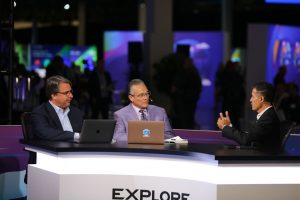 CLOUD
CLOUD
 CLOUD
CLOUD
 CLOUD
CLOUD
One of the clear messages to emerge from the VMware Explore conference in Las Vegas this week is that VMware remains fully committed to providing infrastructure solutions, and one of the most critical areas where enterprises will be looking for those solutions is at the edge.
VMware LLC announced several new developments across its product portfolio this week, including enhancements for its Edge Compute Stack, which is emerging as a central element in VMware’s overall endpoint strategy.

Broadcom’s Sanjay Uppal talks with theCUBE about VMware’s Edge Compute Stack.
“There’s many physical locations … [that] tend to be extremely distributed, but they’re extremely heterogeneous as well,” said Sanjay Uppal (pictured), senior vice president and general manager for the software-defined edge division at Broadcom Inc. “You need to provide access from those locations to the applications that are sitting in the data center. A lot of the data is being generated at the endpoints of the enterprise. If you locate information and compute close to where the endpoints are generating data, then the logical conclusion is that you’ve got to take a stack and then put it at these edge locations, and that’s what our Edge Compute Stack does.”
Uppal spoke with theCUBE Research’s Dave Vellante and John Furrier at VMware Explore, during an exclusive broadcast on theCUBE, SiliconANGLE Media’s livestreaming studio. They discussed VMware’s edge strategy and the impact of growing AI use cases on enterprise compute solutions. (* Disclosure below.)
Uppal uses the analogy of a cookie to describe VMware’s evolving edge offerings. At the bottom layer is the VMware Telco Cloud Platform, where clients can modernize their infrastructure. At the top is the Edge Compute Stack for running workloads in different environments. And the middle is VeloCloud for connecting branches together and providing context for applications, including generative AI.
“You have this cookie, and what we’re doing now is we are telling people, ‘Take a bite out of the whole cookie,’” Uppal said. “Deploy Edge Compute Stack, you have Velo underneath, and then your Telco Cloud Platform. You have all the intelligence to optimize these generative AI workloads. Edge AI is coming, the big tsunami is here.”
The wave of generative AI will also bring the use of agents, intelligent pieces of software that can autonomously perform tasks. VMware is preparing for this new opportunity, according to Uppal, where many agents will be driven by small language models or SLMs.
“We play solidly in the infrastructure, so we will be able to support the SLMs,” Uppal said. “In fact, we have created three SLMs to run on the Edge Compute Stack. My belief is that the agentic approach is actually going to take over, because it makes the most sense for how human beings want their questions to be answered.”
Growing use of AI agents could also have a major impact on the telecommunications industry. VMware and other key players in the telco arena will be looking ahead to the major MWC trade show in Barcelona next year for signals on where this key development could be headed.
“If we can achieve a breakthrough by MWC, it will be using this AI agentic approach to get some new monetizable services because that’s where the whole industry is stuck,” Uppal explained. “We’ve been talking for I don’t know how many decades about a common API which will make the applications write to the API. This layer in the middle is the key to solving that problem, a layer that recognizes, understands the application … and translates what the application wants down to the network.”
VMware’s strategy for the edge is based on a belief that AI will drive multimodal interfaces, where intelligent models will communicate with each other using data from different locations.
“If you just take this conversation we’re having, if it’s stretched out to one hour, that would be 1 million tokens,” Uppal said. “Those one million tokens would be sent to the cloud, and then we would ask, ‘What’s the most interest part of this conversation?’ Everywhere that we’re sitting is an edge and it’s becoming multimodal. That’s what the future’s going to bring, everything multimodal, everything upstream so that it’s made intelligent by small language models and large language models that are talking peer-to-peer with one another.”
Here’s the complete video interview, part of SiliconANGLE’s and theCUBE Research’s coverage of VMware Explore:
(* Disclosure: VMware by Broadcom sponsored this segment of theCUBE. Neither VMware nor other sponsors have editorial control over content on theCUBE or SiliconANGLE.)
Support our mission to keep content open and free by engaging with theCUBE community. Join theCUBE’s Alumni Trust Network, where technology leaders connect, share intelligence and create opportunities.
Founded by tech visionaries John Furrier and Dave Vellante, SiliconANGLE Media has built a dynamic ecosystem of industry-leading digital media brands that reach 15+ million elite tech professionals. Our new proprietary theCUBE AI Video Cloud is breaking ground in audience interaction, leveraging theCUBEai.com neural network to help technology companies make data-driven decisions and stay at the forefront of industry conversations.